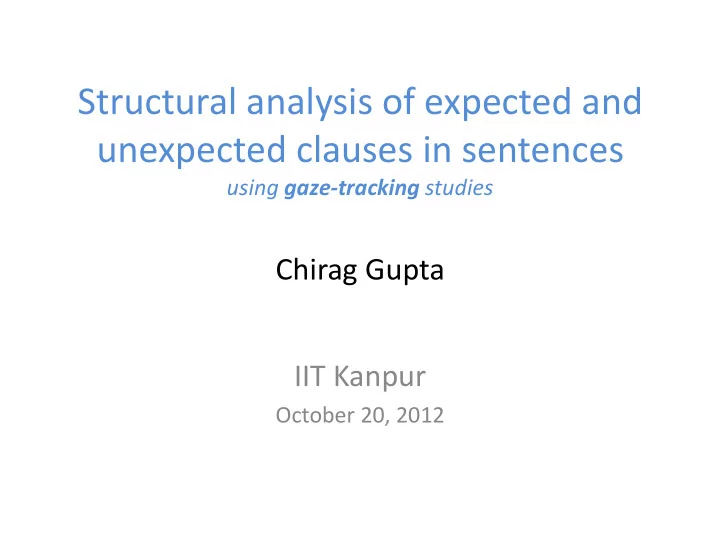

Structural analysis of expected and unexpected clauses in sentences using gaze-tracking studies Chirag Gupta IIT Kanpur October 20, 2012
Introduction • Consider the following sentences The ball was kicked by Bhutia into the goal. The ball was kicked into the goal by Bhutia. Bhutia kicked the ball into the goal. • Above sentences are all grammatically correct. • Only the third one seems natural. • First two sentences have an added adverbial clause, that could be avoided.
Incremental evaluation • The brain constructs parse trees incrementally, or by looking at the local context of the phrase. • How would the brain parse the following two sentences? • “The mango was eaten by Aniket ”
The mango was eaten by Aniket. S ? ?
The mango was eaten by Aniket. S NP D N ? The mango
The mango was eaten by Aniket. S NP D N AUX ? The mango was
The mango was eaten by Aniket. S NP D N VP AUX The mango was V ? eaten
The mango was eaten by Aniket. S NP D N VP AUX The mango was NP V eaten by Aniket
Ambiguities in incremental evaluation • What happens with such sentences? • “ Buffalo buffalo Buffalo buffalo buffalo buffalo Buffalo buffalo ” Source: Wikipedia
Garden path sentences • Definition : A grammatically correct sentence that starts off in such a way that a reader's interpretation using the most likely parse in incremental evaluation will be incorrect. The reader is lured into a parse that turns out to be a dead end. Source: Wikipedia • “As the police stopped the driver became very frightened” Source: Pickering and Traxler , ‘98
Garden path sentences • Definition : A grammatically correct sentence that starts off in such a way that a reader's interpretation using the most likely parse in incremental evaluation will be incorrect. The reader is lured into a parse that turns out to be a dead end. Source: Wikipedia • “As the police stopped the driver became very frightened” Source: Pickering and Traxler , ‘98 • In speech, ambiguities are much easier to resolve due to punctuation related inflections.
Disambiguation and reanalysis • On hitting a clause that is unexpected with respect to the current analysis, a disambiguation occurs through reanalysis. • These effects can be observed, in gaze-tracking studies, by statistical analysis of 1. Regressions: moving from the current spot to a spot on the left. 2. First pass time 3. Overall fixation time. • Note that parts 1 and 2 focus on a local clause, and are concerned with its plausibility, whereas part 3 deals with the sentence as a whole.
Study 1 (replication) • Traxler and Pickering (‘98) study the effect of garden path sentences have, using gaze tracking studies. • Unnatural / unexpected parts of sentences will have larger first pass time and regressions as compared to naturally expected parts. • Sentences that contain unexpected clauses will have a larger total pass time .
Subordinate-clause ambiguities • “As the woman edited the magazine amused all the reporters”
Subordinate-clause ambiguities • “As the woman edited the magazine amused all the reporters” • Object analysis (‘magazine’) turns out to be wrong. ‘Amused’ indicates that it must be the subject of the verb phrase, and not the object of the noun phrase.
Attachment to a more plausible clause • Pickering and Traxler (‘98) noted that first pass time was longer if the first part of the clause was more plausible. • Readers ‘attached themselves more strongly’ to that clause. – As the woman edited the magazine amused all the reporters. (difficulty in reanalysis) – As the woman sailed the magazine amused all the reporters. (more easily reanalyzed)
Complement-clause ambiguities • “The criminal confessed his sins harmed too many people.”
Complement-clause ambiguities • “The criminal confessed his sins harmed too many people.” • Again, we can have a plausible object phrase, and an implausible one. Consider,
Complement-clause ambiguities • “The criminal confessed his sins harmed too many people.” • Again, we can have a plausible object phrase, and an implausible one. Consider, • “The criminal confessed his gang harmed too many people.”
‘Control’ sentences • As the woman edited the magazine amused all the reporters As the woman edited , the magazine amused all the reporters • The criminal confessed his sins harmed too many people The criminal confessed that his sins harmed too many people
Proposition • The above work also ‘induces’ the following two classes of sentences. • Those that are plausible, and also have an expected structure VS those that are plausible, but have an unexpected structure. – The magician touched the boy with a wand. – The magician touched the boy with a ball. • Both sentences completely natural, punctuated, and in their most canonical forms. Yet, the first one is more easily parsed.
Study 2 (proposed) • What sentential structures are more natural? • A paragraph containing around 15 sentences of various syntactic forms . • All sentences grossly plausible . • Pass time, and number of regressions measured for each sentence. • Followed by an ANOVA on average reading time and variance across subjects, for various sentences.
References : • “Plausibility and Recovery From Garden Paths: An Eye -Tracking Study”, Pickering and Traxler ’98 • “The time -course of the application of binding constraints in reference resolution”, Sturt ‘03 • “Plausibility and the Processing of Unbounded Dependencies: An Eye- Tracking Study”, Pickering and Taxler ’98 • “Eye movements in reading and information processing: 20 years of research”, Rayner and Keith ’98 • “The On-line Study of Sentence Comprehension: Eyetracking, ERPs and Beyond”, book by Manuel Carreiras ‘04
Recommend
More recommend